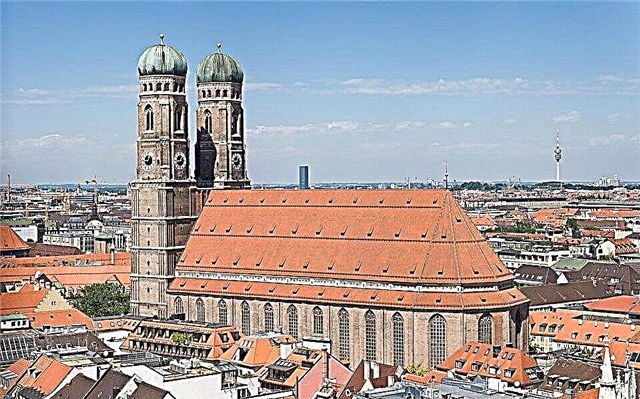Address: Russia, Moscow Region, Sergiev Posad, Red Army Avenue, 123
Foundation date: 1918 year
Exposure: Russian folk toy, New Year's and Christmas toys, Toy of the countries of the East, Russian and Western European toys of the 19th - early 20th centuries, Children's portrait
Coordinates: 56 ° 18'18.1 "N 38 ° 07'46.4" E
Content:
Each of us keeps fond memories of our first favorite toys. That is why a visit to the Sergiev Posad Museum gives a lot of pleasure not only to children, but also to their parents, and even grandmothers and grandfathers. The unique collection was assembled almost a hundred years ago, largely thanks to the efforts of the outstanding art critic, artist and museum expert Nikolai Dmitrievich Bartram.
History of the creation of the Toy Museum
The first collection of the museum was founded in Moscow in 1918. Its creator was the owner of a four-room apartment in 8 on Smolensky Boulevard, art critic Nikolai Dmitrievich Bartram. At one time, father Nikolai Bartram had his own small workshop, where Dmitry Ernestovich created toys on his own. He taught this craft to his son. Nikolai became seriously interested in the history of Russian toys and called it nothing but a mirror of life. As a young man, he began to collect the first collection of toys of domestic and foreign production.
In 1921, a poster was displayed urging children to go “to their museum”. And the "toy kingdom" has become very popular among young Muscovites. The museum was constantly replenished with exhibits from nationalized estates, palaces and private collections. And four years after its opening, it has grown so much that it was forced to move to a separate mansion on the street. Prechistenka, formerly owned by the Khrushchev-Seleznevs. Nikolai Dmitrievich directed his brainchild until his death in 1931.
In the same year, the museum moved from Moscow to Zagorsk. This name was then borne by Sergiev Posad. Museum funds alternately moved from one institution to another, until in 1980 they occupied an old red-brick mansion on Mount Volokusha, not far from the Trinity-Sergievskaya Lavra, on the banks of the Kelarsky pond. Here he is to this day.
The choice of Sergiev Posad to host the unique "doll kingdom" was not at all accidental. For more than three hundred years in the city and its suburbs, the folk craft of making toys has been developing, according to experts - the largest in Russia. Nesting dolls and dolls have been made here for a long time. Craftsmen from the village of Bogorodskoye, located not far from the city, became especially famous. Local hereditary craftsmen carve original toys from lime wood, using simple plots of peasant life. Children like these wooden crafts very much, because they have special movement mechanisms.
Permanent collections and exhibitions of the Toy Museum
The modern collection of the "toy" museum is huge and includes more than 30 thousand unique exhibits, located in several halls. In the "royal" hall of the museum exposition there are about 300 toys, which were owned by the family of Emperor Nicholas II.
These are amazingly beautiful dolls made in Germany and France, miniature dresses and dishes, soft toys, entertaining board games and outdoor games, as well as several mechanical toys of that time - exact copies of steam locomotives, airplanes and steamers. It is interesting that the costumes for the royal dolls were made to order in Russia and represented samples of the national costumes of some of the peoples who inhabited our country.
A separate, very interesting section of the museum exhibition shows samples of traditional Russian folk toys. What materials were not used to create it - wood, straw, cones, twigs, fabrics, clay ... For many centuries Russia has become famous for its Kargopol, Filimonov, Gorodets and Dymkovo toys. Some of the most interesting exhibits in the folk toy hall are a miniature architectural set of the Trinity-Sergius Lavra made in the 19th century, as well as a rich collection of 19th century nesting dolls. The oldest toy in the Sergiev Posad Museum is about 1000 years old.
This is a clay whistle found during archaeological excavations in Kiev. And the most popular section is the toys of the Soviet era, made in the pre-war and post-war years. Grandparents who come to the museum always like to show their grandchildren the signs of their childhood.
The museum collection also represents the traditional culture of making toys in the countries of the East - in Japan, India, Korea, China and Mongolia. The collection was based on the personal collection of Japanese netsuke collected by N.D. Bartram back in the late XIX - early XX century. There is also a small Japanese house made of tortoiseshell and wood, clay dolls in Chinese costumes and wooden Japanese kokeshi.
There are also original musical toys in the museum, which were made for children from wealthy noble families who lived in Western Europe. The collection includes samples created in the late 19th and early 20th centuries: a singing bird in a cage and a girl playing the piano.
The museum staff will conduct a separate tour of the unique collection of children's portraits. During such an excursion, you can understand how this genre was born and developed, as well as learn about the creative path of portrait painters, whose works hang on the walls of the museum - Vasily Tropinin, Pyotr Shamshin, Fedor Tulov and other painters.
Over the long years of its existence, the collection of the Toy Museum has visited many parts of Russia and abroad, and the building in Sergiev Posad has hosted interesting exhibitions from different countries.
How to get to the Toy Museum
The museum is housed in an old two-story brick building built by the architect A. Lotkov at the turn of the 19th and 20th centuries. for the city male school (Red Army Avenue, 123). From the railway station of Sergiev Posad and the bus station located near it, you first need to go down to the Red Army Avenue, and along it walk to the museum. This path is small and is about 0.5 km. The road will take less than 10 minutes.
If you get to Sergiev Posad from Moscow by car, then you need to enter the city along the Moscow highway, which, closer to the historical center, turns into Red Army Avenue. The museum is located on the left in the direction of travel, 0.5 km before the Troitsko-Sergievskaya Lavra.
The museum accepts visitors from 10.00 to 17.00, except Monday and Tuesday. It has its own souvenir shop, and in a separate hall there is a small toy library, where children can play with a variety of toys for their own pleasure.











